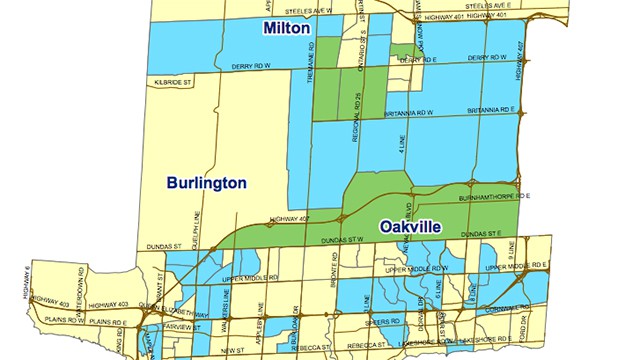This is Where Everyone is Moving To in Oakville
Published July 19, 2017 at 5:23 pm

Over the past few years, there’s been a lot of talk about the incredible growth that Halton — including Oakville, Burlington, and Milton —has enjoyed and is expecting to continue to see over the ne
Over the past few years, there’s been a lot of talk about the incredible growth that Halton — including Oakville, Burlington, and Milton —has enjoyed and is expecting to continue to see over the next few years.
But where exactly is it happening?
There are six high-growth neighbourhoods across Halton – four in Milton, and one apiece in Oakville and Burlington – with an average population increase of more than 5,000, according to a new Community Lens report from Community Development Halton.
Growth in Oakville is predominantly in the north end along Dundas St. sandwiching Hwy. 407.
“In general, a neighbourhood with significant increase in population implies an increase in demand for goods and services,” reads the CDH report.
It means more sales and customers, and “for government, it means more services such as schools, libraries, garbage pickups, health, and social services. To a large extent, the reverse is true for neighbourhoods with considerable decline in population.”
Some people might have been surprised to see that Oakville’s population didn’t grow much at all between 2011 and 2016, according to the 2016 Census.
Oakville’s population inched up to 193,832 from 182,520 people five years ago.
That means the city experienced about six per cent growth.
While the climb is modest, Oakville is still holding firm as a desirable place to live in Canada, as is Halton overall.
Oakville’s future growth “is focussed on high transit nodes to preserve our stable established neighbourhoods,” according to a social media post by Mayor Rob Burton.
If you look at the map, green denotes growth between 2011 to 2016 — as a result of planning decisions between 1992 and 2006, according to Burton.
Blue represents where we didn’t grow or in some cases, lost population.
The no/negative growth neighbourhoods, which total 38, averaged a decrease of about 80 people, the report finds.

Interestingly enough, Oakville’s neighbours are also experiencing overall growth in the last five years.
Burlington and Halton Hills are seeing a slight uptick, with Burlington growing 4.3 per cent from 2011 until now (to 183,314 from 175,779 people).
Halton Hills is home to 61,161 people — up 3.6 per cent from 59,013 in 2011.

Milton, meanwhile (in a league of its own) is experiencing incredible growth, with its population increasing to 110,128 from 84,362 (meaning it saw a pretty wild 31 per cent increase).
And age is a telling factor across Halton.
In high-growth neighbourhoods, more than one in five residents is less than 10-years-old compared to one in 10 for the no/negative growth neighbourhoods, the report finds.
“In the no/negative growth neighbourhoods, one in seven (16 per cent) persons is a senior. On the other hand, seniors only represent about 5 per cent of the population in high-growth neighbourhoods.”
What are your thoughts on growth in Halton?
insauga's Editorial Standards and Policies advertising





